#peramelidae
Text


For some reason I came across the lower jaw bone of some vertebrate. This was later identified as a Northern Brown Bandicoot jaw bone.
24/09/23 - Isoodon macrourus
QLD:WET - El Arish, farmland road
#Isoodon macrourus#Northern Brown Bandicoot#Peramelidae#Bandicoots#Marsupialia#Marsupials#Mammalia#Mammals#Vertebrata#Vertebrates#Chordata#Chordates#bones#dead tw
14 notes
·
View notes
Text

Bandicoots in the genus Isoodon: Golden Bandicoot I. auratus; Northern Brown Bandicoot I. macrourus; Southern Brown Bandicoot I. obesulus.
From Menkhorst and Knight (2001) 'A Field Guide to the Mammals of Australia'
#animals#australian animals#mammals#australian mammals#marsupials#australian marsupials#bandicoots#golden bandicoot#northern brown bandicoot#southern brown bandicoot#s o: australidelphia#o: peramelemorphia#f: peramelidae#s f: peramelinae#g: isoodon#sp: i. auratus#sp: i. macrourus#sp: i. obesulus
1 note
·
View note
Text
bandicoot-pés-de-porco
O bandicoot-pés-de-porco(a) (Chaeropus ecaudatus) era um marsupial da família Chaeropodidae, encontrado nas regiões áridas do interior da Austrália. O último exemplar foi coletado em 1907 nas redondezas do Lago Eire, Austrália do Sul. Registros não confirmados foram feitos até a década de 1920 por moradores locais e aborígenes.
Chaeropus ecaudatus

Classificação científicaedit
Domínio: Eukaryota
Reino: Animalia
Filo: Chordata
Classe: Mammalia
Infraclasse: Marsupialia
Ordem: Peramelemorphia
Família: †Chaeropodidae
Gênero: †Chaeropus
Espécies: †C. ecaudatus
Segundo a taxonomia de McKenna e Bell (1997), a Chaeropodidae era considerada uma subfamília da Peramelidae. Análises moleculares (Westerman et al. 1999, 2001) não mantiveram este arranjo, e indicaram que o Chaeropus é o grupo-irmão de todos os outros Peramelemorphia, e portanto pertencia a uma família própria.
Nota (a): O termo "bandicoot" constitui um estrangeirismo, não possuindo termo equivalente em português, sendo assim o nome comum constitui um vernáculo artificial, pois deriva do nome popular em língua inglesa
Não há muitas informações sobre bandicoot-pés-de-porco
0 notes
Photo
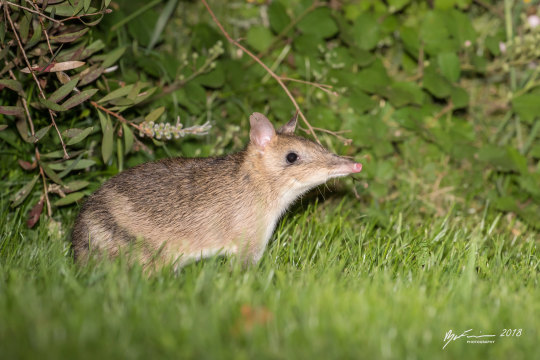
Eastern barred bandicoot (Perameles gunnii)
Photo by Ryan Francis
#eastern barred bandicoot#bandicoot#perameles gunnii#perameles#peramelinae#peramelidae#peramelemorphia#australidelphia#marsupialia#metatheria#mammalia#tetrapoda#vertebrata#chordata
115 notes
·
View notes
Text

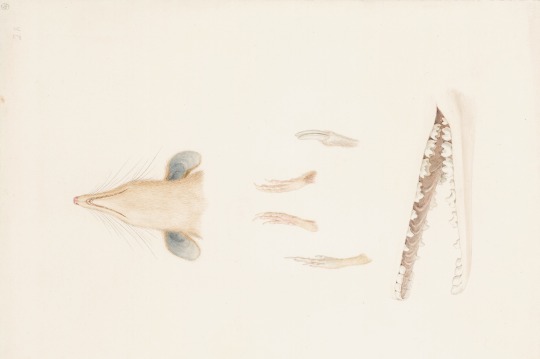
Western Barred Bandicoot, Perameles bougainville (1801) - Ferdinand Bauer
#Wonder Rooms#Cabinet of Curiosities#Public Domain#19th Century#Natural History#Scientific Illustration#Ferdinand Bauer#Zoology#Animalia#Mammalia#Marsupialia#Peramelemorphia#Peramelidae#Perameles
8 notes
·
View notes
Text
#1564 - Isoodon obesulus ssp. fusciventer - Quenda


I’m rather surprised that I haven’t covered these before.
Also known as the Southern Brown Bandicoot. As you can see for marsupials they're pretty rat-like, and indeed it seems likely bandicoots were so named after an Indian rodent Bandicota indica that the explorer Bass knew about, in 1799.
Quendas are omnivores (again, like rats), and like all bandicoots, thrive on insects, fruit, seeds, and fungi. These marsupials also enjoy the shortest gestation of any mammal - 11 days - but for some reason still felt the need to independently invent the placenta (not feeling so special NOW, are you 'higher mammals'?).
Brown bandicoots breed all year around as long as they have water available. A litter of two to five joeys spend six weeks in the backwards-facing pouch before mum kicks them out. A bit rude, because despite being born with claws - 'milk claws'? - the babies loose them again after reaching the pouch. Probably just as well though, I doubt she'd enjoy being kicked repeatedly in the nipples with their adult claws, once they grow them. They reach breeding age a month after being turfed out, and patrol their territories usually at night, and rest in grassy nests during the day.
Despite the threats posed by cars (as here) and cats (as happened to the last one I rescued) Quendas are quite common in Perth suburbs, and quickly become used to humans, and will forage in daylight hours especially if tomato sandwiches are in the offing.
3 notes
·
View notes
Text
Vocabulary (pt.dcclxxxviii)
Words taken from The Thorn Birds (1977) by Colleen McCullough:
yaws (pl. n.)
a contagious tropical skin disease with large red swellings.
beriberi (n.)
a disease causing inflammation of the nerves due to a deficiency of vitamin B1 (thiamine), and mainly associated with rice-based diets.
Atabrine (n.)
trademark. another term for quinacrine.
Gurkha (n.)
a member of the principal Hindu race in Nepal.
atoll (n.)
a ring-shaped coral reef enclosing a lagoon.
cay (n.)
a low insular bank or reef of coral, sand, etc.
hydrocephalus (n.)
an accumulation of fluid in the brain, especially in young children, which makes the head enlarge and can cause mental handicap.
schism (n.)
the division of a group into opposing sections or parties.
bandicoot (n.)
any of the small insect- and plant-eating marsupials of the family Peramelidae, found in Australasia.
French letter (n.)
British informal. a condom.
1 note
·
View note
Text
Factoide #2059
El famoso Crash y su hermana Coco de la saga de videojuegos Crash Bandicoot, están inspirados en los bandicuts.
Los peramélidos (Peramelidae) son una familia de mamíferos marsupiales parecidos a una rata, conocidos también como bandicuts (bandicoot en inglés)
El personaje trajo tanta atención hacia la especie, que cuando se descubrieron los restos fosilizados de una subespecie desconocida de bandicut llamaron a la subespecie "Crash Bandicoot"
[Publicado originalmente el 26 de Junio del 2017]
0 notes
Text
The Bandicoot
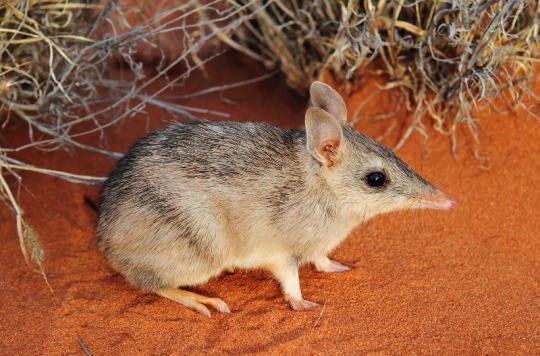
Scientific name:
Perameles
Taxonomic Classification:
Kingdom: Animalia
Phylum: Chordata
Class: Mammalia
Order: Peramelemorphia
Family: Peramelidae
Nutritional Requirement:
The Bandicoot will eat both plant and animal matter and will primarily feed on insects that Bandicoot will hunt by digging up the ground. Bandicoot has also been known to eat fruits, berries, nuts, seeds, eggs and even small rodents when they are a desperate need for food.
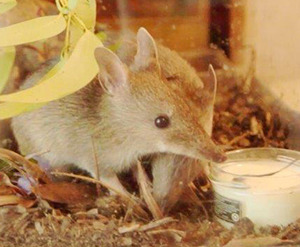
Growth and development:
Bandicoot is marsupials, this means that young Bandicoot will spend most of its early life in its mother's nursing pouch. The Bandicoot will nurse from its mother until it reaches full strength and a full size of 28cm - 81cm with a weight 0.2kg - 1.6kg. The Bandicoot will live 3-7 years
Behavior:
The Bandicoot is primarily solitary and nocturnal. This means the Bandicoot will spend it’s daylight hours hiding in bushlands and creek beds and then it will spend its nighttime hours hunting for food. Due to Bandicoot’s small size, it has a large number of predators including large birds, foxes, snakes, wildcats, and humans. This large selections of predators for the Bandicoot have played a part in the Bandicoot endangered status.
Reproduction:
Bandicoots are mainly solitary creature but they will meet up with other Bandicoots in order to mate. Bandicoot’s don’t have any specific mating season and they have the shortest gestation period of any mammal with the young being born just 12 days after conception. A female with normally give birth to a litter of 3-6 young and she will nurse them in her pouch until they are strong.
Evolutionary Origins:
Bandicoots are closely related to rats.
Habitat:
Found in the Australian wilderness
Fun Fact:
The name bandicoot is taken from the term ‘pandi-kokku’ which means ‘pig-rat’ in Telugu, an Indian language
Thank you for Reading!
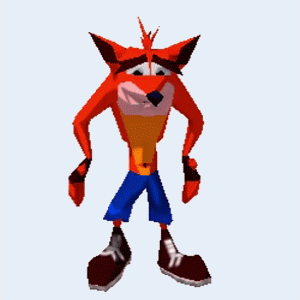
Sources:
https://a-z-animals.com/animals/bandicoot/
https://www.bushheritage.org.au/species/bandicoots
Image credit:
http://www.australianwildlife.org/media/213684/western-barred-bandicoot-low-res-copyright-awc.jpg
https://www.wires.org.au/wildlife-info/wildlife-education/Bandicoot.jpg
2 notes
·
View notes
Text
Bandicoot
Bandicoot, slightly, is very similar to the mouse or rat. The body is covered by the fur with varied color. The tail is like a cable but it is getting smaller on the tip. There are around 22 sub-species of animals under the bandicoot category. All of them are included in the family of Peramelidae.
Although it is almost the same with the mouse, a bandicoot is surely not a mouse. This is a marsupial animal, a name for mammals with pockets without the placenta and umbilical cord when they are still infants. Bandicoot itself is an omnivore. As a pet, the owners may feed it with the insects, plants, and mushrooms.
0 notes
Photo

Southern Brown Bandicoot (Isoodon obesulus), A Hand-book to the Marsupialia and Monotremata (1894) - Richard Lydekker
#natural history#southern brown bandicoot#animals#mammals#marsupials#o: peramelemorphia#f: peramelidae#s f: peramelinae#g: isoodon#sp: i. obesulus
2 notes
·
View notes